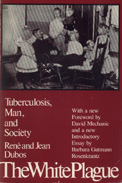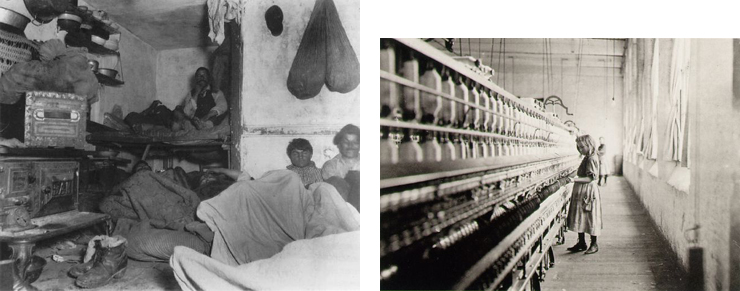The White Plague, (1952) René and Jean Dubos
![]()
 Part One: The Nineteenth Century
Part One: The Nineteenth Century
Part Two: The Causes of Tuberculosis
Part Three: Cure and Prevention of TB
Part Four: Tuberculosis and Society

The living and working condition in the dawn of the Twentieth century photographically recorded.
![]()
Part One: The Nineteenth Century
Chapter 2: Death Warrant for Keats
Chapter 3: Flight from the North Winds
Chapter 4: Contagion and Heredity
Chapter 5: Consumption and the Romantic Age.
Part Two: The Causes of Tuberculosis
Chapter 6: Phthisis, Consumption, Tubercles
Chapter 7: Percussion, the Unitarian Theory
Chapter 8: The Germ Theory
Chapter 9: Infection and Disease
Part Three: Cure and Prevention of TB
Chapter 10: Evaluating Therapeutic Procedures
Chapter 11: Treatment and Natural Resistance
Chapter 12: Drugs, Vaccines and Public Health
Chapter 13: Healthy Living and Sanitoria
Part Four: TB and Society
Chapter 14: The evolution of Epidemics
Chapter 15: Industrial civilization
Chapter 16: Social Technology
![]()
Forward
René & Jean Dubos
Combined and epidemiological with an ecological approach
As both
1. “A methodological improvement in the understanding of health,”
2. “the basis of a humanistic philosophy that could help preserve the best qualities of mankind through the awareness of the complex interrelationships between populations and environments.”
Vii
Introduction
“disease was a prevalent and destructive experience that threatened social order....Human history and tubercle bacillus are so enmeshed that to follow the course of the disease over time is a prerequisite to understanding what the whole struggle to control disease means to ourselves and our contemporary society.”
Xii
“reflections about the medical and social conception of tuberculosis.”
Consumptive personal ą microbe specific, disease causing agent (1882)ąsocial hygiene/public health stages with the introduction of first therapy and second antibiotic treatment phases.
“Tuberculosis, however, was already a less ominous disease for the audience that read The White Plague when it was first published in 1952.
100,00 case per annum of which declined from 34,000 to 11,000 annually.
Jean and René Dubos called tuberculosis ‘a social disease’ in order to associate the disease with poverty, although the term was more commonly associated with sexually transmitted diseases.”
“Economic and social conditions, the Duboses stressed, were crucial factors in its transmission.”
“. . . had profound social consequences in that it affected the ‘emotional and intellectual climate of the societies it attacked’.”
xv
“it is emphatically a disease of the 19th century.” Industrialism and pollution
“Alongside their account of the social ecology of tuberculosis, the Duboses celebrate the history of scientific research that culminated in Robert Koch’s discovery of the tubercle bacillus in 1882.”
“It was at last possible to show the common pathology of different symptoms and the necessary bacterial origin of every tubercular infection.”
“...first examining the complex social environment that generated the conditions of disease, and the second celebrating the growth of scientific knowledge about the biology of tuberculosis, added an important tension to the Duboses’ narrative. . . .”
“Resistance to infection was the best explanation for this fall in the death rates.”
xvi
“On the other hand, the discovery of tubercle bacillus and the demonstration of its necessary role in disease failed, at first, to change the minds of many doctors and the public, who continued to blame the incidence of tuberculosis on heredity, climate, or psychogenic causes.”
xvi-xvii
“Evidence that pathogenic organisms, including tubercle bacillus, developed drug resistant strains underscored the potential for medical disaster and the need for therapeutic prudence.”
“Nature reveals many roads that lead to the direction of truth.” R&J Dubos own words
“transform the human experience of illness.”
xvii
“They perceived a danger in the scientific and social logic that aimed to treat the disease rather than to modify the underlying causes of vulnerability, and their own moral logic served to inform their history of tuberculosis.”
xviii
Chapter 3: Flight from the North Winds
Keats and Shelley, (Paganini, Tsarevitch Nicolas, and famous families Bronte’s, Trolopes)
“They were part of a great pilgrimage, begun long before, leading the sick from the Northern fog toward the Southern sun–shrine of health joy and illusion.”
“the Mediterranean coast as ‘the last ditch of the consumptive’.”
19
“But for most Americans, the Southern and Western states were less forbidding than Europe. Florida and the Caribbean Islands, and later Colorado, New Mexico, and Arizona, provided for North American consumptives the illusion of refuge with which the Mediterranean lured their European brothers in disease.”
25
Cecil Rhodes went to Natal for the cure from Oxford.
26
Cicero – cured or health improved considerably by sea voyages
27.
Chapter 4: Contagion and Heredity
Southern European doctors believed in contagion –exposure
Northern European doctors believed in heredity, a predisposition due to inheritance (families)
Chapter 14: The evolution of Epidemics
1650 and 1850 the high mortality periods for TB in Britain & Europe.
400 in 1835 for Boston, New York, and Philadelphia
26 in 1950
morbidity rates deaths per one hundred thousand
185
“That tuberculosis began to decrease long before any special measures had been instituted against the disease–indeed, before there was any scientific basis on which to formulate anti-tuberculosis campaigns.”
long before the microbiological discovery of TB bacteria, the rate of morbidity & mortality was falling, even before the antitubercular campaign.
185-8
“the treatment and segregation of patients in sanatoria did not gain momentum until 1900; vaccination is only now (1950s) coming into use and is not practiced at all in some of the places where mortality has reached its lowest level, as to therapeutic measures–like lung collapse, thoracic surgery, and the use of streptomycin and PAS–they are of too recent date to have played a part in the phenomenon.”
“But even at this lower level (200/100,000) tuberculosis remained the greatest killer of the human race, and it is not surprising, therefore, that many physicians and public health officers remained for a time unaware of the downward trend that had begun spontaneously.”
186
“TB is not the only infectious disease that exhibits an apparently spontaneous ebb and flow. Most epidemics first appear in the form of a few sporadic cases; this is the early phase followed by one of great prevalence and severity; then new cases become progressively fewer and fewer, the disease often taking a benign character before disappearing almost completely for a time.”
“there are on record, for example, many outbreaks of epidemic influenza recurring at intervals of apparently twenty years: but it is probable that the profound changes in the distribution of populations and in medical practices during the past few decades will blur considerably, or even eliminate completely, the regularity of this epidemic cycle.”
187
“Tests in experimental animals have so far failed to give any indication that the virulence of TB has significantly decreased during historical times, or at least since the bacteriological era.”
187-88.
“However, it is much more difficult to demonstrate the role of inherited susceptibility and resistance in the general population, partly because genetic traits are distributed in such a complex manner that they fail to appear as a clear pattern, partly because the influence of environmental factors on the course of tuberculosis is so great as to mask the manifestations of hereditary characteristics.”
“...most of the susceptible die young without leaving any progeny.” {
[hence chances of inherited disease proclivity is decreased]
“Selective elimination of the most susceptible”
“there is evidence that repeated exposure to infection confers on survivors an acquired immunity which supplements their innate endowments”
189
“they become allergic to tuberculin without ever showing any evidence of clinical disease.”
“Exposure in childhood, over time “may have led progressively to the development in urbanized areas of a partially immune population.”
“tuberculosis usually exhibits a very acute course in populations newly exposed to it.”
190
9000 / 100,000 Indians in western Canada were infected with TB once they abandoned their hunting way of life and settled down into sedentary villages.
40% of the deaths in Hawaii and New Caledonia, after contact, were attributed to TB.
191
“European people of Celtic origin appear to be particularly susceptible to TB.”
192
“The history of TB in different human populations makes it plain that racial (ethnic) susceptibility or resistance is to a very large extent a consequence of social history.”
• Rural nomadic people become susceptible to virulent TB
• Urban exposed populations become resistant to TB
“…it is also true that living conditions are (diet?) of paramount importance in determining the severity of this response.”
From 83 / 100,000 [Manhattan] to 52/100,000 [Bronx] among densely settled and less densely settle Jewish communities in NYC .
193
“wretched economic status” can mask the otherwise decline in cases among less dense populations.
TB in Paris shot up during the siege of the Franco-Prussian War, 1871
194
“Thus the course of TB during and after the war illustrates in a striking manner the powers at the disposal of the human body to master the disease when living conditions are favorable.”
195
“It seems that the severity of TB immediately reflect the complex of disturbances brought about in the community as a whole by most forms of social upheavals, be they abrupt changes in ancestral habits, rapid industrialization, or wars.”
195-96
“Obviously the equilibrium between man and the tubercle bacillus is very precarious.”
196
"The lack of elementary sanitation was beyond our most ghastly imaginings.
204
"promiscuous spitting long remained as readily accepted as in the days when Samuel Pepys wrote in his diary, . . . a lady spit backwards upon me by mistake, not."
204-205
"The intensity of the contagion must have been enormous. Keats, Poe, Thoreau, and Trudeau nursing their dying brothers at home in small, closed rooms, without any precautionary measures; the BrontĎ children exposed for years to chronic 'bronchitis' of their father, . . . – these are typical examples of a behavior that was then commonplace."
205
Dialectical Themes
descriptive versus empirical
Chaos versus Cosmos
Contagionists versus Hereditarists
